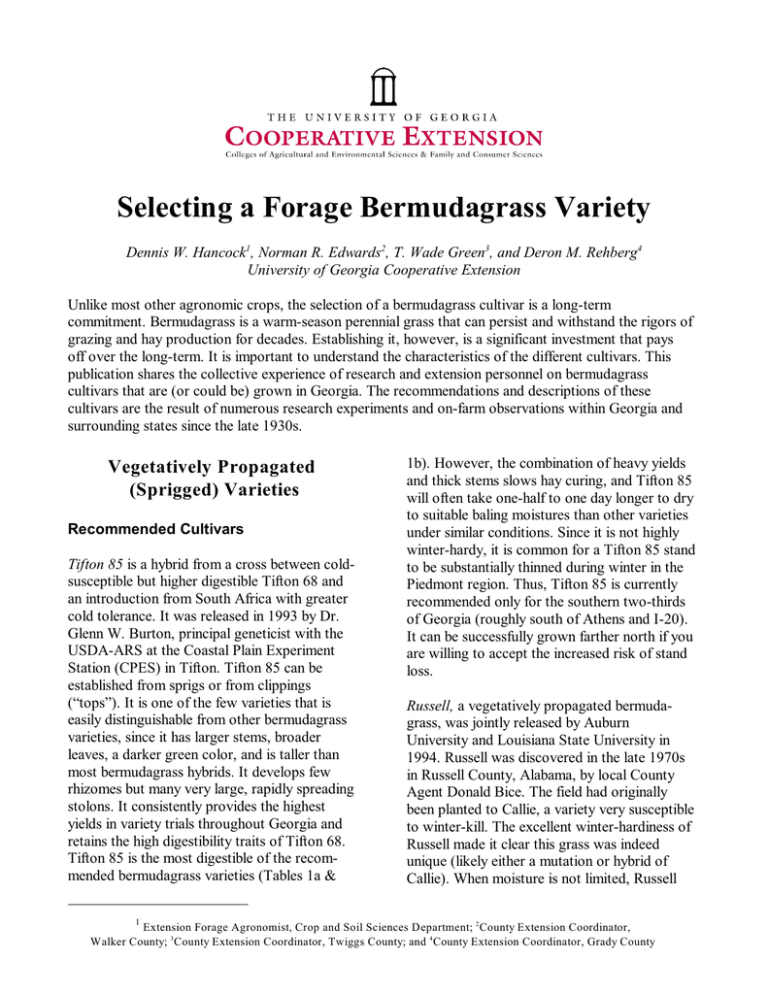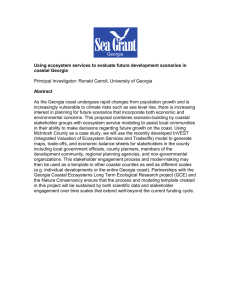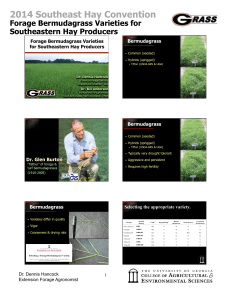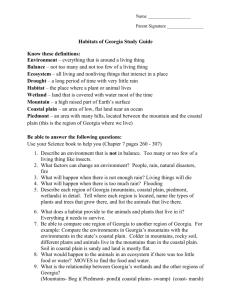Selecting a Forage Bermudagrass Variety
advertisement

Selecting a Forage Bermudagrass Variety Dennis W. Hancock1, Norman R. Edwards2, T. Wade Green3, and Deron M. Rehberg4 University of Georgia Cooperative Extension Unlike most other agronomic crops, the selection of a bermudagrass cultivar is a long-term commitment. Bermudagrass is a warm-season perennial grass that can persist and withstand the rigors of grazing and hay production for decades. Establishing it, however, is a significant investment that pays off over the long-term. It is important to understand the characteristics of the different cultivars. This publication shares the collective experience of research and extension personnel on bermudagrass cultivars that are (or could be) grown in Georgia. The recommendations and descriptions of these cultivars are the result of numerous research experiments and on-farm observations within Georgia and surrounding states since the late 1930s. Vegetatively Propagated (Sprigged) Varieties Recommended Cultivars Tifton 85 is a hybrid from a cross between coldsusceptible but higher digestible Tifton 68 and an introduction from South Africa with greater cold tolerance. It was released in 1993 by Dr. Glenn W. Burton, principal geneticist with the USDA-ARS at the Coastal Plain Experiment Station (CPES) in Tifton. Tifton 85 can be established from sprigs or from clippings (“tops”). It is one of the few varieties that is easily distinguishable from other bermudagrass varieties, since it has larger stems, broader leaves, a darker green color, and is taller than most bermudagrass hybrids. It develops few rhizomes but many very large, rapidly spreading stolons. It consistently provides the highest yields in variety trials throughout Georgia and retains the high digestibility traits of Tifton 68. Tifton 85 is the most digestible of the recommended bermudagrass varieties (Tables 1a & 1 1b). However, the combination of heavy yields and thick stems slows hay curing, and Tifton 85 will often take one-half to one day longer to dry to suitable baling moistures than other varieties under similar conditions. Since it is not highly winter-hardy, it is common for a Tifton 85 stand to be substantially thinned during winter in the Piedmont region. Thus, Tifton 85 is currently recommended only for the southern two-thirds of Georgia (roughly south of Athens and I-20). It can be successfully grown farther north if you are willing to accept the increased risk of stand loss. Russell, a vegetatively propagated bermudagrass, was jointly released by Auburn University and Louisiana State University in 1994. Russell was discovered in the late 1970s in Russell County, Alabama, by local County Agent Donald Bice. The field had originally been planted to Callie, a variety very susceptible to winter-kill. The excellent winter-hardiness of Russell made it clear this grass was indeed unique (likely either a mutation or hybrid of Callie). When moisture is not limited, Russell Extension Forage Agronomist, Crop and Soil Sciences Department; 2 County Extension Coordinator, Walker County; 3 County Extension Coordinator, Twiggs County; and 4 County Extension Coordinator, Grady County Coastal, released in 1943, is the first hybrid forage bermudagrass from Dr. Burton’s work at the CPES. It is an F1 hybrid between an introduction from South Africa and a prolific bermudagrass found in a south Georgia cotton patch. Named for the experiment station where it was bred, Coastal is among the most successful forage variety releases in the past century as it makes up some 15 million acres of the hay and pasture land in the southern United States. It is the standard against which other varieties are measured. Coastal is a tallgrowing, intermediate, coarse-stemmed type, has both rhizomes and stolons, produces few viable seed, and has excellent drought tolerance. Coastal establishes well from both sprigs and clippings (tops). In Georgia, Coastal is best adapted to the Coastal Plain and lower Piedmont areas. It is not as cold tolerant as Tifton 44 or Russell and could winter-kill in the mountains. Coastal produces twice as much forage as common bermudagrass, and its forage quality is superior to common Alicia and a few other varieties when properly managed. may out-yield all bermudagrasses in the first harvest and match the high seasonal yield totals of Tifton 85. Russell is also noted to spread rapidly and has been rated higher for winterhardiness than Coastal. Forage height at the appropriate harvest intervals is typically shorter than other high-yielding bermudagrass hybrids, but the forage is quite dense. Despite its highyield potential, Russell is somewhat less drought tolerant than Tifton 85. Furthermore, Russell is substantially less digestible than Tifton 85 and slightly less than or equal to Coastal. Russell produces both rhizomes and stolons, develops one of the best root systems of all the hybrids, and forms a dense sod that holds up well under grazing. Russell can be established from sprigs or clippings (tops) and often is quicker to establish than Tifton 85. Russell is a solid variety that is recommended throughout Georgia. Tifton 44, a winter-hardy hybrid bermudagrass, was released in 1978. Tifton 44 is a cross between Coastal and a winter-hardy bermudagrass found near a railroad track in Berlin, Germany. Its winter-hardiness allows successful growth as far north as Kentucky and Virginia, more than 100 miles north of the recommended range of Coastal bermudagrass. This hybrid produces more rhizomes, has finer stems, is darker green, and forms a denser sod than Coastal. It is better adapted to the northern areas of the bermudagrass growing regions of the country than many other varieties. Though it can perform well in the Coastal Plain, Tifton 44 will likely yield less in this area than the other recommended hybrids. It is slower to establish than many other varieties and may not establish well if propagated from clippings (tops). As a result of this slow establishment, it usually will not provide any significant grazing/haying during the establishment year. Tifton 44 bermudagrass produces a higher-quality forage than Coastal or Alicia, averaging 7 percent higher in digestibility than Coastal and 10 percent higher than Alicia. Hay yields of Tifton 44 are similar to Coastal. Tifton 44 starts growing in early spring and grows later into the fall than Coastal or Alicia in northern latitudes. Noteworthy Upcoming Release Coastcross II is a mutant selection from Coastcross I, a bermudagrass that had very poor winter-hardiness. Coastcross II is currently in the process of being released by Dr. William Anderson, Research Geneticist with the USDA-ARS’s Crop Genetics and Breeding Research Unit at the CPES. Coastcross II grows taller and has broader, softer leaves. Though it is less winter-hardy than Coastal, it is similar to Tifton 85 in that it produces very high yields, and has superior quality and improved digestibility. This hybrid can be established from sprigs and tops; it has rapidly spreading stolons but develops few rhizomes. 2 Other Varieties bermudagrass belt. Midland 99, a newer selection from this line, has a wider geographic range of adaptation. For Georgia, Midland fails to yield or persist as well as Tifton 44, so it is not recommended. Alicia was selected from introductions from Africa and marketed by a Texas businessman in the early 1970s. Alicia is relatively easy to establish from sprigs or clippings (tops) and produces high hay yields similar to Coastal and Tifton 44. Its forage is much less digestible and lower in quality than Tifton 85 and even Coastal. Alicia is very susceptible to leaf-spot and may not consistently provide a thick stand. As a result, Alicia is not recommended in Georgia. Tifton 68 was released from Dr. Burton’s breeding program at the CPES in 1984. It is a hybrid of two highly digestible plant introductions. It has large stems and stolons (no rhizomes) that spread rapidly. However, Tifton 68 has poor winter-hardiness and is not recommended. Callie, released by Mississippi State University, is a selection from a group of highly digestible bermudagrasses introduced from Kenya. Callie produces good quality forage and yields well where it is adapted, but it is not cold tolerant and will winter-kill in Georgia during severe winters. Therefore, Callie is not recommended in Georgia. Tifton 78, released in 1984, is a hybrid bermudagrass. Tifton 78 is the best of many crosses made between Tifton 44 and Callie. Compared with Coastal, Tifton 78 grows taller, has larger stems and a similar rhizome system, spreads much faster, is more easily established (sprigs and tops), and starts growth earlier in the spring. In tests at Tifton, this hybrid produced 25 percent more dry matter (hay yields) than Coastal and averaged 7.4 percent higher in digestibility. It has excellent resistance to leafspot, a foliage disease that destroys leaf tissue and reduces yields and quality. Tifton 78 is less winter-hardy than Tifton 44. It is well-adapted throughout the Coastal Plain and may be grown to a limited degree in the lower Piedmont. Plantings in the Piedmont may experience some stand thinning during winter, so Tifton 78 is recommended only for areas south of the Fall Line. Tifton 85 was released soon after Tifton 78. Tifton 85 has higher yields and quality than Tifton 78. As a result, Tifton 85 is a better choice for new plantings than Tifton 78 in South Georgia and the Coastal Plain region. Coastcross I, released by Dr. Burton in 1967, is a hybrid of Coastal and a very digestible bermudagrass from Kenya. Coastcross I grows taller, has broader, softer leaves and produces higher quality forage than Coastal, but it is not winter-hardy. Coastcross I will winter-kill in south Georgia during severe winters and, therefore, is not recommended in Georgia. Grazer was bred at Tifton as a hybrid of a selection found in the Alps of north Italy and introductions from Kenya. Yield performance was poor (10-15% less than Coastal) in Tifton. Excellent digestibility and performance in Louisiana led to the release of Grazer there in 1985. Poor yields prevent its recommendation for Georgia. World Feeder, a naturally-developed, vegetatively propagated bermudagrass, was found by a producer in Oklahoma and has been marketed by Agricultural Enterprises of Oklahoma City. World Feeder is winter-hardy, but has demonstrated poor yields and digestibility in trials and demonstration plots in Georgia and several other states. It is very susceptible to leaf-spot diseases leading to many reports of stand decline/failure in World Feeder Midland was released in 1953 by Dr. Burton and colleagues in Oklahoma. A hybrid of Coastal and a winter-hardy common from Indiana, it is similar to Coastal in yield, growth habit, and forage quality. Some Midland stands still exist in north Georgia; however, the variety has largely been replaced by Tifton 44. It is more widely grown north of the Coastal 3 plantings in Georgia. Therefore, it is not recommended for Georgia. bermudagrass, some or all of which may have been hulled to remove the seed husk for faster germination. These blends may be prone to revert to common (that is, common will ultimately dominate the stand). Despite the expense, seeding recommended cultivars alone (not in a blend) is more likely to lead to better results over the long-term because these varieties are more hardy, produce higher yields, limit weed intrusion, and maintain better quality. Several other vegetatively propagated bermudagrass varieties are available, many of which are releases from university or USDA breeding efforts. Among these, Brazos, Hardie, Oklan, and Quickstand have not performed well in Georgia or are known to not be well-adapted. Of course, many others have not been adequately evaluated in Georgia including Florakirk, Greenfield, Hill Farm Coastcross-I, Jiggs, Lancaster, LeGrange, Luling, Naiser, Scheffield, Summerall, Suwannee, Zimmerly, and any others not listed here. Recommended Cultivars Cheyenne, a seeded bermudagrass cultivar, has exceptionally good persistence, is winter-hardy in Georgia, and consistently performed well in yield trials throughout the state (Tables 3a and 3b). The forage quality (protein, fiber, and digestibility) of Cheyenne is quite similar to Coastal, but it is slightly lower than CD90160 and KF-194. Cheyenne has not been a prolific seed producer. This has limited the availability of seed from this cultivar. Recently, clones of Cheyenne were selected for improved seed production by Texas A&M University and Seeds West. The product of this selection, Cheyenne II, has been shown to match the yield and persistence of Cheyenne in initial evaluations. Cheyenne II is now being sold and used in seed blends such as Ranchero Frio. Seed Propagated Varieties Seeded bermudagrass varieties generally have low yields and low forage quality when compared to improved hybrids. However, sprigging an improved hybrid bermudagrass is expensive and risky, especially where small acreages drive up the cost per acre and rolling terrain leaves soil prone to erosion for a significant period of time. Producers often find that planting seed is the most feasible establishment option. Ironically, the most hardy and persistent varieties will often produce little seed. These varieties can be expensive. Seed companies will often help offset this problem by offering seed blends, so it is important to closely evaluate and compare seed tags. These blends usually contain one or more of the top varieties in mixtures with varieties that are more prolific seed producers (Table 2). Though these more prolific seed producers (such as Giant and Jackpot) grow very well in the establishment year, they are not usually persistent and are often very short lived in Georgia. However, by the time these components of the mix die out, the more persistent varieties may be capable of filling in the gaps. Unfortunately, these gaps often exist in early spring when weeds are growing but the bermudagrass is not. Alternatively, companies may fill out a blend by mixing in common CD90160, a seeded bermudagrass cultivar, is most often sold in seed blends such as Vaquero, Gaucho, Sungrazer Plus, and Sungrazer 777. When grown alone, this cultivar matches the yield, winter-hardiness, and persistence of Cheyenne. CD90160 has also shown to have higher protein (increased by 20%) and digestible nutrients (increased by 14%) than Cheyenne. KF-194 is often sold in seed blends such as Sungrazer Plus and Sungrazer 777. Like CD90160, this cultivar also matches the yield, winter-hardiness, and persistence of Cheyenne. KF-194 shares the high forage quality characteristics of CD90160. 4 Other Varieties with fescue and clover. Though Common bermudagrass is an important part of pastures and hayfields in Georgia, it is not recommended for new seedings simply because improved seeded varieties (recommended above) will consistently out-yield and provide higher quality forage than Common. Common bermudagrass is certainly welladapted to the humid South and quickly became a widespread weed in cultivated crops after its introduction in the 18th century. Common produces viable seed and spreads by stolons and rhizomes. Once established, it is difficult to eradicate. Common bermudagrass is present, usually in combination with fescue or as a contaminant in improved bermudagrass pastures, on more than 400,000 acres in Georgia. It is hardy, forms a dense sod, and can be established from seed and maintained on infertile soils. Although Common does not provide high yields (often 50% as much hay per acre as Coastal), it can be effectively used in forage programs to provide summer grazing. In north Georgia, it is best used in combination Many other seeded bermudagrass varieties are available. Most of these releases are from private companies and turfgrass breeding efforts. Many have been shown to have persistence problems or yield poorly, such as Giant, Guymon, Jackpot, and Wrangler, and are therefore not recommended. Mirage, Mohawk, Pyramid, and many other varieties not listed have not been adequately evaluated under Georgia’s conditions. Tables Table 1a. Summary of the characteristics of the primary vegetatively propagated (sprigged) bermudagrasses in Georgia. Yield * Digestibility ** Winter Hardiness Persistence Leaf Spot Resistance Alicia (Alecia) 100 P G P P Coastal 100 F G G E Coastcross II 135 E G ND ND Russell 130 G E E G Tifton 44 90 G E G E Tifton 78 120 E F F E Tifton 85 135 E F E E Variety Overall Rating Ratings: E = Excellent, G = Good, F = Fair, P = Poor. * Yields are expressed as a percent of yields from Coastal. ** Based on in vitro dry m atter digestibility. N D Insufficient data exists to accurately estim ate these param eters. Coastcross II rem ains a relatively new variety and has not yet been evaluated as rigorously as other hybrids. 5 Table 1b. Summary of the characteristics of the primary vegetatively propagated (sprigged) bermudagrasses in Georgia. Recommended for: Variety Mountain Upper Piedmont Low er Piedmont Coastal Plain % % % ND % % % Russell % % % % Tifton 44 % % % % % Alicia (Alecia) Coastal Coastcross II Tifton 78 Tifton 85 ND % Insufficient data exists to accurately estim ate these param eters. Coastcross II rem ains a relatively new variety and has not yet been evaluated as rigorously as other hybrids. Table 2. Blends of seeded bermudagrasses. Trade Name Components Morhay Com m on, Giant Pasto Rico Com m on, Giant Pasture Suprem e Com m on, Giant Ranchero Frio Cheyenne, Mohawk, Giant Sungrazer 777 KF 194, CD90160, Jackpot Sungrazer Plus KF 194, CD90160, Giant Texas Tough Com m on, Giant Tierra Verde Com m on, Giant Vaquero Mirage, Pyram id, CD90160 6 Table 3a. Summary of the characteristics of the primary seeded bermudagrasses in Georgia. Yield* Winter Hardiness Persistence Giant (NK37) 55 P P Cheyenne** 60 G E CD90160 60 G E KF-194 60 G E W rangler 55 E F Com m on 50 G G Variety Overall Rating Ratings: E = Excellent, G = Good, F = Fair, P = Poor. * Yields are expressed as a percent of yields from Coastal. ** The original Cheyenne is no longer being sold. Cheyenne II, a variant of Cheyenne (selected for higher seed yield), is currently being m arketed. Cheyenne II is expected to have characteristics sim ilar to Cheyenne. Table 3b. Summary of the characteristics of the primary seeded bermudagrasses in Georgia. Variety Recommended for Georgia Comments Fast growing, but short-lived seeded variety. Northrup King has the only nam ed variety of Giant. Giant (NK37) Cheyenne** % Most reliable of seeded varieties grown Georgia. CD90160 % Solid perform er, but m ost com m only sold as one of three com ponents in a blend. KF-194 % Another solid perform er that is prim arily sold as a com ponent in seed blends. W rangler Good variety for northern-m ost counties, but it has not persisted well in variety trials in m ost of Georgia. Com m on Default pasture species throughout m ost of Georgia, but it suffers from poor yields and susceptibility to disease. Ratings: E = Excellent, G = Good, F = Fair, P = Poor. * Yields are expressed as a percent of yields from Coastal. ** The original Cheyenne is no longer being sold. Cheyenne II, a variant of Cheyenne (selected for higher seed yield), is currently being m arketed. Cheyenne II is expected to have characteristics sim ilar to Cheyenne. 7 The University of Georgia and Ft. Valley State University, the U.S. Department of Agriculture and counties of the state cooperating. Cooperative Extension, the University of Georgia College of Agricultural and Environmental Sciences, offers educational programs, assistance and materials to all people without regard to race, color, national origin, age, gender or disability. An Equal Opportunity Employer/Affirm ative Action Organization Comm itted to a Diverse W ork Force C919 January 2008 Issued in furtherance of Cooperative Extension work, Acts of May 8 and June 30, 1914, The University of Georgia College of Agricultural and Environmental Sciences and the U.S. Department of Agriculture cooperating. J. Scott Angle, Dean and Director






